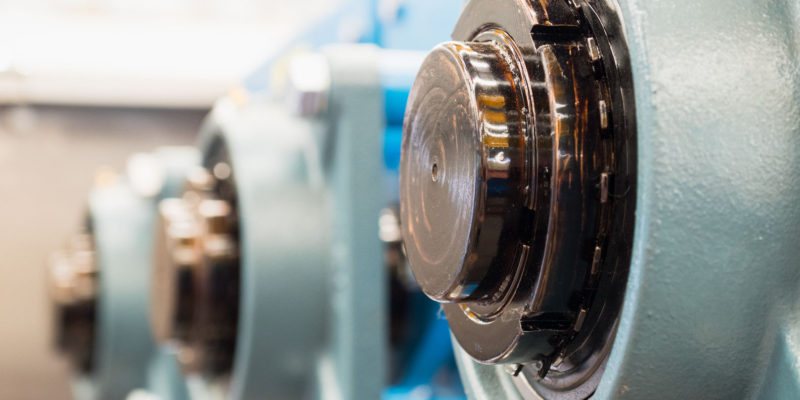
Grease consists of a liquid lubricant that is mixed with a thickener ( see OilChat #15 ). Additives imparting special properties may also be included. Although is is liquid lubricant ( and certain additives) in the grease that provides the necessary lubrication, grease and oil are not interchangeable in their applications. The combination of the thickener, fluid and additives incorporated in grease produce certain properties or characteristics that grease does not share with lubricating oil.
The characteristics most commonly considered when selecting grease for a specific application included, but are not limited to the following:
Consistency is a key property of grease and is a measure of the relative hardness of the grease. Consistency is measured using a “penetrometer”. A cone is released and allowed to sink into the grease, under its own weight, for 5 seconds. The depth that the cone has penetrated into the grease is then read in tenths of a millimeter. The further the cone penetrates the grease, the higher the penetration result and the softer the grease. The National Lubricating Grease Institute (NLGI) has established consistency numbers ranging from 000 to 6, corresponding to specified ranges of penetration numbers. The table below lists the NLGI grease classifications along with a description of the consistency and how it relates to common foods:
[wpsm_comparison_table id=”7″ class=””]
NLGI 2 grease is the most common consistency used globally
Dropping Point is indicative of the heat resistance of grease. The Dropping Point is the temperature at which grease becomes fluid enough to drip under controlled conditions in a laboratory test. In general, the dropping point is the temperature at which the grease passes from a semisolid to a liquid state. This change is irreversible in greases containing conventional soap thickeners. Greases with materials other than conventional soap thickeners can, without a change in state, separate oil. The dropping point indicates the upper-temperature limit at which a grease retains its structure and NOT the maximum temperature at which a grease may be used. A good rule of thumb is to consider the dropping point minus 50°C as the maximum useful temperature limit.
Oxidation Stability is the ability of grease to resist breakdown in reaction with oxygen at elevated temperatures. Although both the base oil and thickener can oxidize, oxidation is more of a danger to the base oil. Oxidation turns grease into a sludge and causes gummy deposits to form on machine and component surfaces. Oxidized grease will become softer and appear darker. Prolonged exposure to excessive temperatures accelerates oxidation and can even result in carbonization where grease hardens or forms an abrasive black crust.
Structural Stability is a vital performance characteristic of lubricating grease as it is a measure of how the grease consistency will change in service when it is subjected to shear as a result of movement. Grease softening in a bearing may cause the grease are developed through careful selection of the thickness composition and effective manufacturing process.
Water Resistance is the ability of grease ti withstand the effects of water with no or little change in its ability to lubricate. Water can affect the grease stability resulting in hardening of softening. A drop inconsistency can cause the grease to be washed away from the bearing. In some instances, grease may also absorb the water and suspend the oil in the grease forming an emulsion that can reduce lubricity by diluting and changing grease consistency and texture. In extreme case water can displace the oil completely, causing the oil to leak away. In order to maintain its structure, the grease is required t have good water repellence in addition to adequate water tolerance properties.
Pumpability is an indication of how easily pressurized grease will flow through lines, nozzles, and fitting of grease dispensing system. Good pump ability characteristics are particularly important at low operating temperatures or when grease is used in automatic lubrication system where the grease is pumped through long lines from a central reservoir. If the temperature of grease is lowered sufficiently, It will become to viscous to flow and machine operation will be impossible. It is therefore important to check the recommended usable temperature range on the product data sheet when considering grease for arduous climatic condition.
Load Carrying Capacity is defined by the American Society for Testing and Material ( ASTM ) as the maximum load or pressure that can be sustained by a lubricating grease without failure of the sliding contact surfaces. In some circumstances the lubricating oil in the grease will prevent the breakdown of the lubricating fluid film under load, and only the action of anti-wear or extreme pressure (EP) additives in the grease will prevent surface contact and wear. in test to evaluate the load carrying capacty of grease, high loads are applied to moving surfaces that are in contact and lubricated by the grease. There are many test for determining the load carrying ability of grease, but the most commonly used ones are the Timken OK Load test and the Four Ball Weld/ Load Wear Index test.
When selecting grease fo a particular application all of these properties need to be compared to the requirenebts of the application. It could be disastrous to choose a grease based on NLGI grade only. The completed package of grease characteristics, including the fluid component viscosity, must be considered in order to choose the best grease for the job.
Important to remember is that all grease are not compatibile. It is therefore recommended that when changing from one grease to another, all the old grease should be cleaned out before the new grease is applied.

